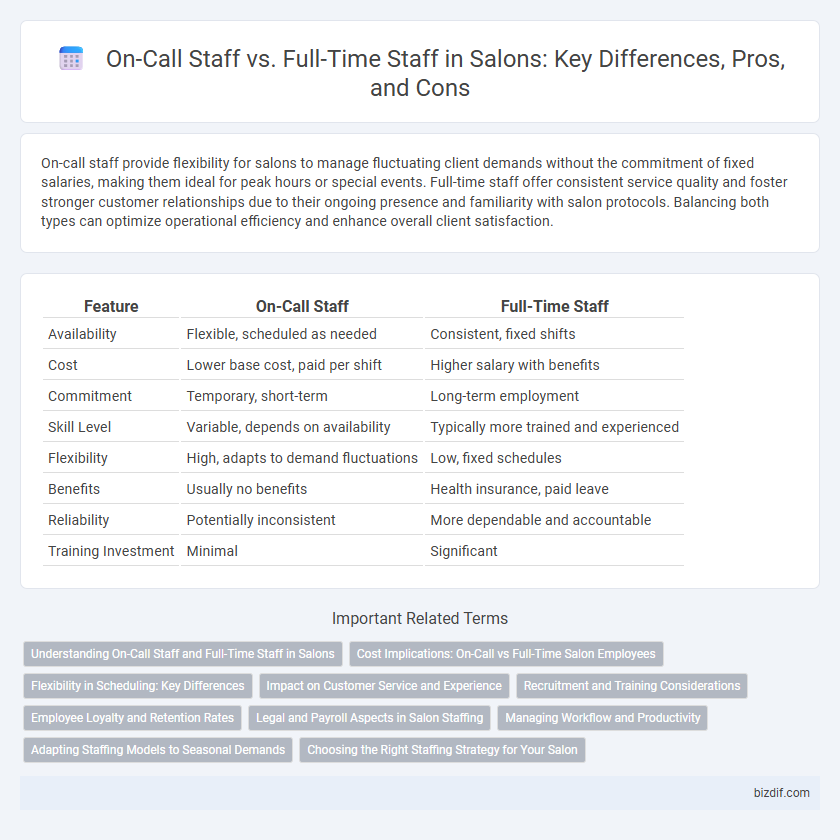On-call staff provide flexibility for salons to manage fluctuating client demands without the commitment of fixed salaries, making them ideal for peak hours or special events. Full-time staff offer consistent service quality and foster stronger customer relationships due to their ongoing presence and familiarity with salon protocols. Balancing both types can optimize operational efficiency and enhance overall client satisfaction.
Table of Comparison
| Feature | On-Call Staff | Full-Time Staff |
|---|---|---|
| Availability | Flexible, scheduled as needed | Consistent, fixed shifts |
| Cost | Lower base cost, paid per shift | Higher salary with benefits |
| Commitment | Temporary, short-term | Long-term employment |
| Skill Level | Variable, depends on availability | Typically more trained and experienced |
| Flexibility | High, adapts to demand fluctuations | Low, fixed schedules |
| Benefits | Usually no benefits | Health insurance, paid leave |
| Reliability | Potentially inconsistent | More dependable and accountable |
| Training Investment | Minimal | Significant |
Understanding On-Call Staff and Full-Time Staff in Salons
On-call staff in salons offer flexible scheduling, allowing salons to manage fluctuating customer demand without committing to fixed salaries, making them ideal for peak hours or special events. Full-time staff provide consistent expertise and foster client relationships through regular availability, contributing to stable revenue and enhanced customer loyalty. Balancing on-call and full-time employees ensures operational efficiency while maintaining high service quality and adaptability.
Cost Implications: On-Call vs Full-Time Salon Employees
On-call salon staff provide flexibility by allowing businesses to adjust labor costs according to client demand, reducing expenses related to hourly wages, overtime, and employee benefits typically associated with full-time employees. Full-time staff incur higher fixed costs, including salaries, health benefits, and paid leave, which can increase overhead but improve service consistency and employee loyalty. Balancing on-call and full-time staff helps salons optimize operational costs while maintaining quality customer service during peak and off-peak hours.
Flexibility in Scheduling: Key Differences
On-call staff in salons offer greater flexibility in scheduling by working only when needed, allowing businesses to adjust workforce levels based on fluctuating customer demand. Full-time staff typically follow fixed schedules with consistent hours, providing stability but less adaptability in managing peak times or unexpected busy periods. This flexibility difference impacts salon operations by balancing labor costs with customer service availability.
Impact on Customer Service and Experience
On-call staff in salons offer flexibility but may result in inconsistent service quality due to varying levels of familiarity with regular clients. Full-time staff typically provide a more personalized and seamless customer experience by building rapport and understanding individual preferences. Consistency and reliability from a dedicated team enhance overall client satisfaction and salon reputation.
Recruitment and Training Considerations
On-call staff in salons offer flexible scheduling and cost efficiency, reducing payroll expenses during low-demand periods without long-term commitment. Full-time staff require comprehensive recruitment targeting industry experience and cultural fit, followed by in-depth training programs to ensure consistent service quality and brand alignment. Balancing on-call and full-time personnel involves evaluating client volume trends and investing in ongoing education to maintain high standards and operational efficiency.
Employee Loyalty and Retention Rates
On-call staff in salons often exhibit lower employee loyalty and retention rates compared to full-time staff due to inconsistent work hours and lack of benefits, which can impact job satisfaction and stability. Full-time salon employees typically receive steady schedules, comprehensive benefits, and career development opportunities, fostering stronger commitment and longer tenure. Salons that prioritize full-time staffing tend to experience reduced turnover costs and a more experienced, loyal workforce.
Legal and Payroll Aspects in Salon Staffing
Salon staffing involves critical legal and payroll considerations when comparing on-call staff to full-time employees. On-call staff typically have flexible schedules but may lack the guaranteed minimum hours and benefits mandated by labor laws, requiring precise contractual agreements to avoid misclassification. Full-time staff generally receive comprehensive benefits, consistent wages subject to payroll taxes, and protections under employment regulations such as the Fair Labor Standards Act.
Managing Workflow and Productivity
On-call staff offer flexibility in managing peak appointment times, enabling salons to efficiently handle sudden increases in customer flow without overstaffing during slower periods. Full-time staff provide consistent availability and deeper familiarity with salon protocols, which enhances workflow continuity and overall productivity. Balancing on-call and full-time employees ensures optimal resource allocation, maintaining service quality while controlling labor costs.
Adapting Staffing Models to Seasonal Demands
Salons optimize operational efficiency by balancing on-call staff with full-time employees to meet fluctuating seasonal demands. On-call staff provide flexibility during peak periods such as holidays and weekends, allowing salons to scale services without the overhead of permanent hires. Full-time staff ensure consistent quality and client relationships year-round, creating a stable foundation for salon operations.
Choosing the Right Staffing Strategy for Your Salon
Choosing the right staffing strategy for your salon involves evaluating the flexibility of on-call staff against the consistency of full-time employees. On-call staff offers scalability to meet fluctuating demand and reduces labor costs during slow periods, while full-time staff ensures reliable service quality and strengthens client relationships through consistent provider availability. Balancing these staffing options based on appointment volume, peak hours, and budget constraints maximizes operational efficiency and client satisfaction.
On-Call Staff vs Full-Time Staff Infographic

 bizdif.com
bizdif.com